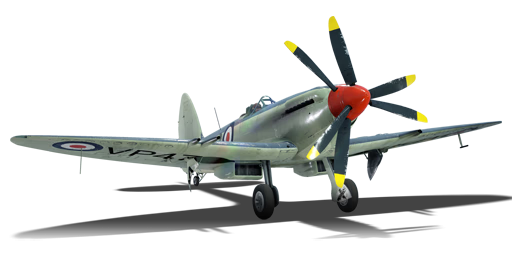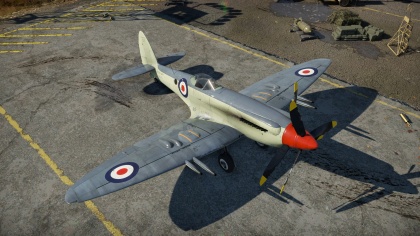Seafire FR 47
Contents
| This page is about the British fighter Seafire FR 47. For other uses, see Spitfire (Family). |
Description
The Seafire FR 47 is a rank IV British fighter
with a battle rating of 5.7 (AB/RB) and 6.0 (SB) It was introduced in Update 1.49 "Weapons of Victory".
Unlike the previous Seafire XVII which is a low altitude fighter, the Seafire FR 47 has excellent high altitude performance, and you will perform most competitively above 6-7 km. It is good for engaging other fighters and bombers up to 12 km due to a 2nd supercharger gear that peaks in power at 8.4 km.
It has has a rather versatile selection of secondary armaments. You can take two 250 lb bombs or two 500 lb bombs. The latter is usually better for attacking ships while the former is preferred for player controlled ground vehicles and for pillboxes. The fact that you can carry rockets is even better. You have a choice of either 4 x RP-3 rockets or 8 x RP-3 rockets. It is more advisable to take 8 x rockets as having only 4 will means both your salvos have to be dead-on the target. This isn't helped by the fact that rockets utilized are woefully inaccurate. When strafing a group of AI light tanks, it is at this point when utilizing 4 rockets make a bit more sense as you are almost guaranteed to take out some of the AI vehicles. If in a mixed RB battle, you should probably not even be carrying rockets and should just stick with bombs, however, if you are attacking vehicles with exposed crew members like the 8.8 cm Flak 37 you can benefit a bit more by using the rockets.
General info
Flight Performance
| Characteristics | |||||||
|---|---|---|---|---|---|---|---|
| Stock | |||||||
| Max Speed (km/h at 7,315 m) |
Max altitude (meters) |
Turn time (seconds) |
Rate of climb (meters/second) |
Take-off run (meters) | |||
| AB | RB | AB | RB | AB | RB | ||
| 694 | 675 | 13,000 | 22.8 | 23.5 | 18.2 | 18.2 | 500 |
| Upgraded | |||||||
| Max Speed (km/h at 7,315 m) |
Max altitude (meters) | Turn time (seconds) | Rate of climb (meters/second) |
Take-off run (meters) | |||
| AB | RB | AB | RB | AB | RB | ||
| ? | ? | 13,000 | ??.? | ??.? | ?.? | ?.? | 500 |
Details
| Features | ||||
|---|---|---|---|---|
| Combat flap | Take-off flap | Landing flap | Air brakes | Arrestor gear |
| ✓ | ✓ | ✓ | X | ✓ |
| Limits | ||||
|---|---|---|---|---|
| Wing-break speed (km/h) |
Gear limit (km/h) |
Combat flap (km/h) |
Max Static G | |
| + | - | |||
| 890 | 330 | 450 | ~12 | ~8 |
| Optimal velocities | |||
|---|---|---|---|
| Ailerons (km/h) |
Rudder (km/h) |
Elevators (km/h) |
Radiator (km/h) |
| < 482 | < 400 | < 500 | > 250 |
| Compressor (RB/SB) | ||
|---|---|---|
| Setting 1 | ||
| Optimal altitude | 100% Engine power | WEP Engine power |
| 4,500 m | 1,530 hp | 2,111 hp |
| Setting 2 | ||
| Optimal altitude | 100% Engine power | WEP Engine power |
| 8,200 m | 1,450 hp | 1,881 hp |
Survivability and armour
- 38 mm Bulletproof glass in cockpit front
- 4 mm Steel plate in pilot's seat
- 6-7 mm Steel plate behind the pilot
- 3 mm Steel box around the wing ammunition
- 1 mm Steel plate on top of the fuel tank and oil cooling system
Armaments
Offensive armament
The Seafire FR 47 is armed with:
- 4 x 20 mm Hispano Mk.V cannon, wing-mounted (134 rpg inner + 114 rpg outer = 496 total)
Suspended armament
The Seafire FR 47 can be outfitted with the following ordinance:
- Without load
- 2 x G.P. 250 lb Mk.IV bombs (500 lb total)
- 2 x G.P. 500 lb Mk.IV bombs (1,000 lb total)
- 4 x RP-3 rockets
- 8 x RP-3 rockets
Usage in the battles
Manual Engine Control
| MEC elements | ||||||
|---|---|---|---|---|---|---|
| Mixer | Pitch | Radiator | Supercharger | Turbocharger | ||
| Oil | Water | Type | ||||
| Controllable | Not controllable | Not controllable | Not controllable | Separate | Not ontrollable | Not controllable |
Modules
| Tier | Flight performance | Survivability | Weaponry | |||
|---|---|---|---|---|---|---|
| I | Fuselage Repair | Radiator | HSBC mk.2 | |||
| II | Compressor | Airframe | HMBC mk.2 | |||
| III | Wings Repair | Engine | Offensive 20 mm | |||
| IV | 150 Octane Fuel | Engine Injection | Cover | New 20 mm Cannons | GRC mk.8 | GRC mk.9 |
- The engine improvements should be prioritized. The engine performance does not improve drastically until you unlock the 150 Octane Fuel.
Pros and cons
Pros:
- Good high altitude performance
- Neutral torque, so cruising is relaxing for the joystick and aiming isn't difficult
- Hispano Mk V cannons means a high rate of fire and high muzzle velocity
- Can land on carriers
- Fast acceleration when diving
- Low silver lion repair fee
- Good top speed for its rank
Cons:
- High stall speed and hence, bricky in its turn (even Bf 109 K-4s on equal speed can out-turn the FR 47)
- Abysmal climb rate at slow speed (Try zoom climbing once you reach about 400 kph), but competitive when fully researched
- Very weak engine when not upgraded
- Play style is completely different than the other Spitfires
History
Describe the history of the creation and combat usage of the aircraft in more detail than in the introduction. If the historical reference turns out to be too big, take it to a separate article, taking a link to an article about the vehicle and adding a block "/ historical reference" (example: https://wiki.warthunder.com/Name-vehicles/historical reference) and add a link to it here using the main template. Be sure to include links to sources at the end of the article.
In-game description
The last and ultimate incarnation in the life of the legendary Spitfire series, the Seafire F Mk.47 which entered service in 1948 was so different from the Spitfire Mk.I that it was barely recognizable. Now fully navalised after the previous Griffon Seafires’ fixed wings, the F Mk.47 was fitted with folding wings and a new Rolls-Royce Griffon 88 which generated 2350 hp at 1250 feet and, fitted with a two-stage two-speed supercharger and petrol injection system, giving a steady flow of fuel under all conditions of accelerated ‘g’. The fastest of all Seafires, the F Mk.47 was capable of reaching over 430 mph at some 24,000 feet.
Compared to other contemporary Royal Navy fighters, the Seafire F Mk.47 was faster in the dive and possessed a greater rate of climb above 25,000 feet than the Sea Fury, the Sea Hornet and, incredibly, the jet powered Sea Vampire. The Seafire could also out roll its contemporaries and was beaten in the turn itself only by the Sea Fury. The contra-rotating propellers which had been introduced on the Seafire F Mk.46 were retained, leading to far greater ease of control input in take off, landing and weapons firing due to the near elimination of torque effect with power changes.
Further modifications included the Spiteful-pattern enlarged fin and rudder, an altered forward fuselage profile and repositioning of the ram-air supercharger intake. Strengthening of the wings allowed a 500 lb bomb to be carried beneath each wing, theoretically allowing the aircraft to carry three 500 lb bombs when also adding a third beneath the fuselage. As with all late marque Seafires, rockets could also be carried. Air-to-air armament consisted of for 20mm Hispano cannon.
Whilst the Seafire F Mk.47 was praised for its control response, handling and deck landing characteristics, it was criticized for its cramped cockpit, uncomfortable seating position, awkward control positioning and lack of modern features such as a properly heated cockpit.
Whilst the Seafire F Mk.47 was one of the greatest piston engine fighters ever produced, it was unfortunately a fighter out of its time period. Advances in jet aircraft meant that piston fighters were finding themselves outclassed more and more with each passing year, and the Seafire F Mk.47 was no exception.
The F Mk.47 first entered service with 804 Naval Air Squadron at RNAS Ford in January 1948. 90 Seafire F Mk.47s were produced, and first saw action in ground attack sorties against bandits in Malaya in October 1949. 800 NAS embarked aboard HMS Triumph were amongst the first aircraft to take part in the Korean War, taking part in their first offensive sorties in July 1950.
Media
An excellent addition to the article will be video guides, as well as screenshots from the game and photos.
Read also
Sources
Paste links to sources and external resources, such as:
- topic on the official game forum;
- page on aircraft encyclopedia;
- other literature.





